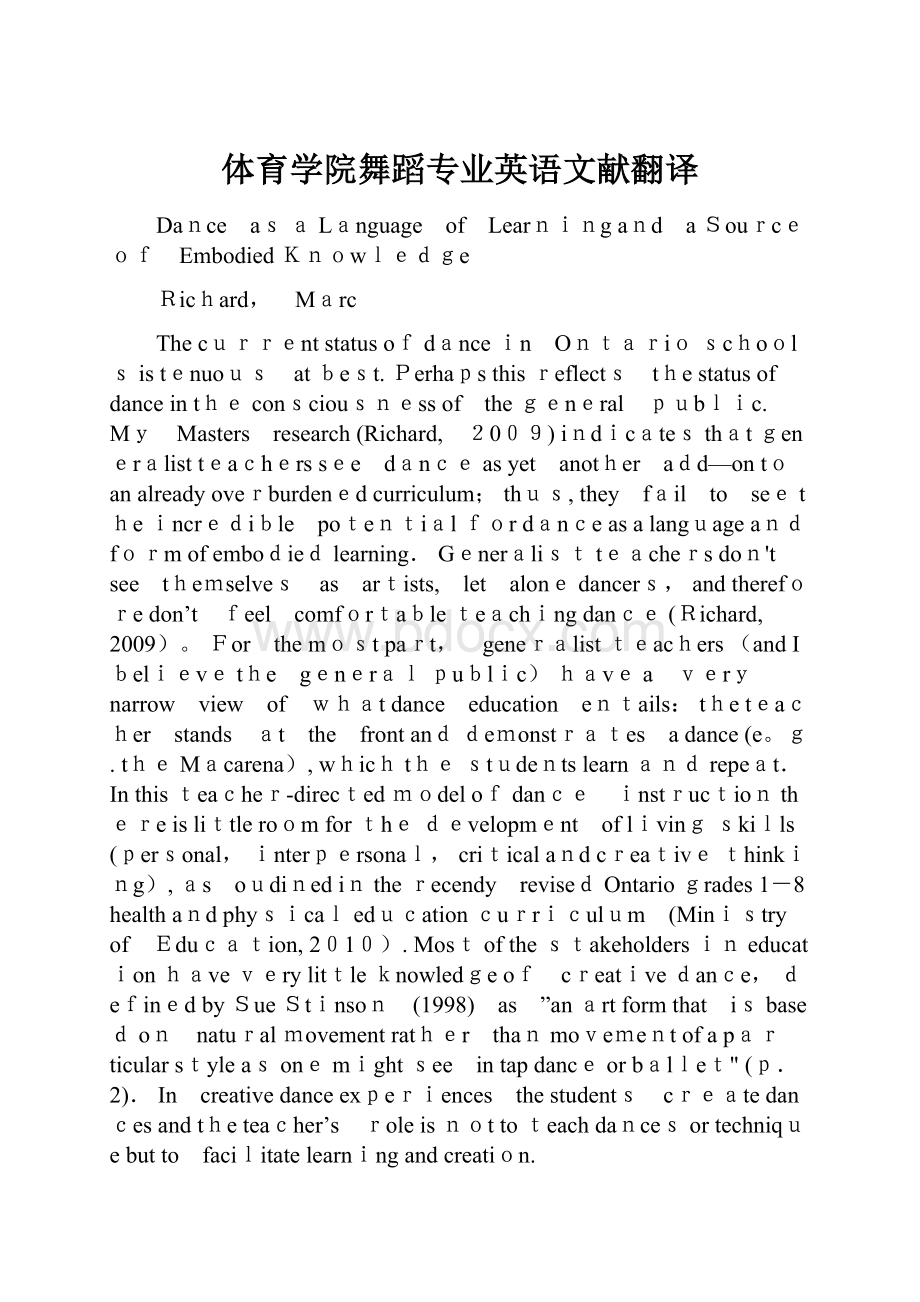体育学院舞蹈专业英语文献翻译.docx
《体育学院舞蹈专业英语文献翻译.docx》由会员分享,可在线阅读,更多相关《体育学院舞蹈专业英语文献翻译.docx(8页珍藏版)》请在冰豆网上搜索。

体育学院舞蹈专业英语文献翻译
Dance asaLanguage of Learningand aSourceof EmbodiedKnowledge
Richard, Marc
Thecurrentstatusofdancein Ontarioschoolsistenuous atbest.Perhapsthisreflects thestatusofdanceintheconsciousnessof thegeneral public. My Masters research(Richard, 2009)indicatesthatgeneralistteacherssee danceasyet another add—ontoanalreadyoverburdenedcurriculum;thus,they fail to seetheincredible potentialfordanceasalanguageandformofembodiedlearning.Generalistteachersdon'tsee themselves as artists, let alonedancers,andthereforedon’t feel comfortableteachingdance(Richard,2009)。
For themostpart, generalistteachers(andIbelievethe generalpublic)havea very narrow view of whatdance education entails:
theteacher stands at the frontanddemonstrates adance(e。
g.theMacarena),whichthestudentslearnandrepeat. Inthisteacher-directedmodelofdance instructionthereislittleroomforthedevelopment oflivingskills (personal,interpersonal,criticalandcreativethinking),as oudinedintherecendy revisedOntariogrades1-8 healthandphysicaleducationcurriculum (Ministryof Education,2010).Mostofthestakeholdersineducationhaveverylittleknowledgeof creativedance,definedbySueStinson (1998) as ”anartformthat isbasedon naturalmovementrather thanmovementofaparticularstyleasonemightsee intapdanceorballet"(p. 2).In creativedanceexperiences thestudents createdancesandtheteacher’s roleisnottoteachdancesortechniquebutto facilitatelearningandcreation.
Makingvisiblethe many profoundmoments ofbodily learningwithin acreativedancesettingmighthelptobroaden definitionsof education and learning.CancienneandSnowber(2009) recognizedanceasauniquesitefor learningabout ourselves,andour world:
"Danceallowsarelationshiptodevelopbetween theouterworldandourbodies...ourbodiesexperiencethingsfirst,viaourphysicalinteraction withtheworld;therefore, therearekindsofdatathatourbodiesexperiencebeforeourminds”(p.188)。
Thisincludes suchthingsasthesensationoftouch,thefeel ofaironour skinaswemovethrough space,as wellasphysicalinteractionswithobjectsand other people.
Formanygeneralist teachers,creativedance education remains anenigma;theseteacherslookto the'real'dancersforsomeideaofwhatcreativedance isandhowtoteachit.Butforstudio-traineddancers,creative danceisequallyelusivebecause theyhavehadveryfewexperiencesas dancestudentswherethey were allowedtocreate。
Joyce(1973)recognizesthat"many gooddancersfailatcreativedanceteachingbecausethey are not sure ofthegoal。
Theyareusedto physicalgoalssuchasteachingthe classtodoacombinationofsteps"(p.12)。
Koff(2000) differentiatesbetween danceeducationanddancetraining, theformerbeingfocusedon”the developmentof self-expressionandinterpretation throughmotionwith self-knowledge asitsaim"andthelatter on”masteryandfixture performance".
InmanyOntario schoolswheredance education isactuallyoccurring,it isveryoftenareplication of teacher—directedstudiodancetraining(i.e。
jazzdance,ballroomdance,video—inspireddances suchasBritney Spearsroutines).Reggio Emiliaeducators,Cavazzoni, Pini,Porani,andRenieri (2007),seem to recognizethedichotomybetweentheworld of dance studios andcreative dance when theyask, "Isabody something totrain,ortolistentoandknow?
Isitacompetitivebody withabilities to conquerorabodyrichincognitive,emotional,andexpressivepotentialities?
"(p。
4).TheseItalianeducators recognize dance andmovement asaway ofknowingand namingtheworld,andasoneofthemanylanguages oflearning.
Making theLearning Visiblein CreativeDanceEducation
Whatisthelearningthathappensincreative danceinan elementary schoolsetting?
Thisresearchprojectinvestigated thelearning forbothteachers andstudentsinfourelementaryschoolsettings inOntario。
Fourgeneralistclassroomteacherswhowerealsoexperienced in teachingcreativedance(as outlined inthedocuments)werevideotapedand photographedwhileteachingcreativedance classes.Afterwards,theseteacherswere interviewedwhilewatchingthe videodocumentation.Fromtheseinterviews,theresearchersobservations, fieldnotes, andphotographs,moments ofperceived learning wereproposedviapedagogicaldocumentationpanels。
Thewords andpictures of studentsandteacherswereplacedon panels andthesewereusedtoprovoke furtherdialogueinthe formof one-on-oneinterviews, andsmallgroupor wholeclassdiscussions。
Alloftheinterviewsand specific momentsfromthevideodocumentationweretranscribed,andalongwiththe photographsandstudents’ worksamples, comprisedadatacollection。
Theoverallfindingssuggestthatin creativedanceclassesstudentsarelearningtodevelop an awarenessoftheirdancingself,an intersubjectivityas theyengageincollaborativecreativeprocessesand discovertheinterconnectednessofdanceasalanguage of learning.Teachers are learningabouttheiruniquerole asa facilitatorincreativedanceclassesanddevelopinganabilitytowitnessthinkingbodies。
TheStudents areLearning to ThinkwiththeirBodies
Creative dance provokes students tousetheirbodiesforthinkingand forsolving problems. Asgrade five teacherBrookeexplained,”Thedepthoftheirthinkingafterhavingthemovementexperiencesisway morethan anyothersubject I’veseen。
..I thinkthereis somethingabout embodyingitfirstthatgives them deeper thinking."Asanother teacher, Alorani,beganherworkwithher gradethreeclass,sheadvisedthemtheywouldbe thinkinginnew ways-theywouldbeshowingrather thantelling.Sheinitiatedanactivitywith thegradethreestudentsinwhichtheywereworkingwitha partner tosuspendtwothinbamboo polesbetweentheir twoindexfingers.
LearningtoUseDanceasaLanguagetoUnderstandOtherDisciplinesofLearning
This themerepresentsall thelearningthat is takingplaceincreative danceclassesthatisnotspecificallyjustaboutlearningindancebutalso learningin othersubject areassuchasdrama,science,math, language,geography,and health. Thisrepresents thelearning throughthe danceportionof the curriculum,i。
e. what studentsarelearning about othersubjectsthroughcreativedance。
Thefirsttime IwitnessedthiswaswithCharlie,afour year-oldkindergartenstudent experimentingwithhis scarf。
Charliewasfocusedonthrowinghisscarfin theair and watching itdescend。
Initially,hewasscrunchingthescarfintoa ball,throwing itup,andwatchingit fall. Next, hisexperimentationwasdifferent- hehad anewtheory,perhapsinspired bythe conceptofsoft, which theywereexploringinthatdayslesson. Helaid out thescarf verycarefully and specificallyonthegroundandthrew it upfromtwocorners。
Thistimethescarfseemedtosuspend in theairand then gentlyfloatdown.He watchedthisactionvery intently.His teacher,Emily,recognized,"He didthe samethingyesterday,buttodayitwasmoresophisticated,ithad tobespread outinacertainway." IshowedCharlieapicture ofhimself as Iinterviewedhim.
DanceasaLanguage ofLearning
Danceisalanguageof learningwithavocabularybased ontheelementsofdance,andstudentscanbecome literateindanceasalanguage.Becausethelanguageofdanceisembodied knowledge,itallowsthe studentstoexpresstheir knowledgeabout many subjectsthroughtheir bodies.As a language oflearning,dancedoesseemtoconnect,asStinson(1998)suggests,tothemind,body,andspirit.The gradesixstudentscertainlyrecognizedit asa”uniquewayoflearning,"that ”didn'treallyfeellike learning"becauseitwasalso”fun.”Bodymovement and thinking with thebodyallowsstudentstodevelop andconnectknowledgeinmanysubjectareas,butalsototheirlives,because thefirstsite oflearning was theirbody。
Fortheveryyoungstudents,theseinterconnections(e。
g.Charlieandhisscarf)are discovered,naturally, throughplay—based experiences。
Forolderstudents, creative dance allowsthemtore-connecttheiroriginalplaybasedmovementlearningwithother subjectsinevenmorecomplexways,e.g. the gradesixstudents'interpretationsofpoems.
Theresultsofthisstudysuggestthatit ispossibleforstudents toknowdanceasanotherimportantlanguageoflearninginourschools。
Students usedtheirthinking bodyin dancetomakeconnections to many othercurriculumareas.Inorderforthistypeofinterconnectionto takeplace however,danceneedstimeonthecurriculartimetable,andthis requiresteachers(and allthe stakeholdersineducation) tovaluedanceand thebodyasa siteoflearning.Wemustreposition dance not asanadd—on tothedaybutas anessentialembodiedform oflearningaboutself,other,andtheworld.
舞蹈可以作为学习和获得知识的一种来源方式
理查德;马克
安大略省舞蹈学校的现状是不容乐观的。
也许这也反映出了公众潜意识里对舞蹈的看法及状态。
我于2009年的一个研究表明,一些具备各种才能的(即所谓的通才)老师,他们认为,在学生课程已经负担过重的情况下,舞蹈的地位很尴尬。
因此,他们看不到舞蹈可以作为一个促进学习和获得知识的渠道之一,让人们可以在轻松愉快的氛围中,取得进步。
那些通才老师不认为自己是艺术家,更不用说是一个舞者,因此他们对舞蹈课程是有偏见的(理查德,2009)。
在大多数情况下,这些所谓的通才老师并不知道舞蹈真正意味着什么,他们简单认为,老师站在前面,演示下舞蹈动作,然后学生学习和反复练习。
在这个舞蹈指导里,老师几乎没有体现出生活技能方面的知识(比如:
人际、批判性和创造性思维等)。
大多数人都不是很了解创造性舞蹈,苏史汀森(1998)将创造性舞蹈定义为一种艺术形式,它是基于自然的运动,而不是一个特定的运动风格,比如:
踢踏舞或者芭蕾舞”.在创造性舞蹈教学与体验中,主要是学生创造舞蹈,教师的角色不是教舞蹈,而是促进学生的学习和创造。
通过舞蹈,我们可以获得很多更深刻的体验,有助于拓宽教育和学习的视野。
Cancienne和Snowber(2009)认为舞蹈的一个独特的功能就是了解我们自己和我们周围的世界:
“舞蹈将外部世界与我们身体联系在一起。
首先,我们的身体通过舞蹈体验,可以与世界互动,这包括诸如触摸的感觉,跳舞时,空气轻抚我们皮肤的感觉,我们穿过空间的约束,与他人交互沟通。
对于那些所谓的通才老师来说,创造性的舞蹈教育仍然是一个迷,他们把握不到舞蹈的真谛,认为舞蹈就是简单的教,以及如何教.但对于那些只知道在舞蹈室练习的舞者来说,创意舞蹈是难以捉摸的,因为他们对于舞蹈也不是有真切的体会。
乔伊斯(1973)认为“很多好的舞者,在创造性舞蹈教学方面,失败的原因就是因为他们不确定教的目的.考夫对舞蹈教育和舞蹈培训做了一个区分,前者注重”通过运动来自我表达,以自我认知为目的,后者则以掌握技能为目标。
安大略的许多学校在舞蹈教育方面,其模式经营经常是对老师所教授的复制和不